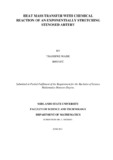Please use this identifier to cite or link to this item:
https://cris.library.msu.ac.zw//handle/11408/3898Full metadata record
| DC Field | Value | Language |
|---|---|---|
| dc.contributor.author | Majiri, Thandiwe | - |
| dc.date.accessioned | 2020-11-19T12:38:57Z | - |
| dc.date.available | 2020-11-19T12:38:57Z | - |
| dc.date.issued | 2013-06 | - |
| dc.identifier.uri | http://hdl.handle.net/11408/3898 | - |
| dc.description.abstract | The laminar boundary layer flow in an exponentially stretching stenosed artery immersed in viscous and incompressible blood is investigated along with the effect of a chemical reaction. Many researchers have used mathematical modelling to predict blood flow through stenosed arteries. Pressure, shear stress and velocity are the parameters that have been analysed in the past. Not a lot of work has been done to highlight the effect of heat transfer on an exponentially stretching stenosed artery with a chemical reaction effect. In this research, stenosis is defined as a condition whereby arteries abnormally narrow. The ability to describe the flow of blood through a stenosed artery provides the possibility of diagnosing the related diseases even before they become clinically relevant. The governing partial differential boundary layer equations in Cartesian Co-ordinate form are first transformed into ordinary differential equations which are then solved by the Runge-Kutta and Shooting methods using the Matlab software package. Potential improvements to previous models have been made by the inco-operation of the effect of exponential stretching of the stenosed artery as blood flows and also by including the effect of a chemical reaction to blood flow. The researcher has come to conclude that the dimensionless temperature field depends on thermal diffusivity (α), the heat component (η) and the dimensionless (U0.D0)/ Re. U0 is the stretching velocity, D0 represents the length of the stenosed portion and Re is the Reynolds’ number. Also, chemical reactions mostly caused by foreign substances to the body, generally lower the flow of blood in arteries. The effects of asymmetric stenosis in a realm of the arterial plaque may be useful for early detection of cardiovascular diseases. Hence the researcher recommends that people take low fat and cholesterol diets as these highly lead to stenotic conditions. Stenotic conditions lead to diseases such as Athesclerosis, Coronary heart disease and high blood pressure. | en_US |
| dc.language.iso | en | en_US |
| dc.publisher | Midlands State University | en_US |
| dc.subject | heat mass transfer | en_US |
| dc.subject | chemical reaction | en_US |
| dc.subject | stenosed artery | en_US |
| dc.title | Heat mass transfer with chemical reaction of an exponnetially stretching stenosed artery | en_US |
| dc.type | Thesis | en_US |
| item.cerifentitytype | Publications | - |
| item.openairetype | Thesis | - |
| item.grantfulltext | open | - |
| item.languageiso639-1 | en | - |
| item.fulltext | With Fulltext | - |
| item.openairecristype | http://purl.org/coar/resource_type/c_18cf | - |
| Appears in Collections: | Bsc Mathematics Honours Degree | |
Files in This Item:
| File | Description | Size | Format | |
|---|---|---|---|---|
| thandiwe majiri R091547C.pdf | Full Text | 1.34 MB | Adobe PDF |  View/Open |
Page view(s)
236
checked on Dec 15, 2025
Download(s)
52
checked on Dec 15, 2025
Google ScholarTM
Check
Items in MSUIR are protected by copyright, with all rights reserved, unless otherwise indicated.



